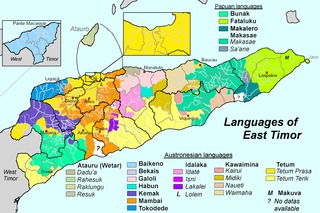
The Papuan languages are the non-Austronesian languages spoken on the western Pacific island of New Guinea, as well as neighbouring islands in Indonesia, Solomon Islands, and East Timor. It is a strictly geographical grouping, and does not imply a genetic relationship.

The languages of East Timor include both Austronesian and Papuan languages. The lingua franca and national language of East Timor is Tetum, an Austronesian language influenced by Portuguese, with which it has equal status as an official language. The language of the Oecusse exclave is Uab Meto (Dawan). Fataluku is a Papuan language widely used in the eastern part of the country. A dialect of Malay-based creole called Dili Malay is spoken by a number of residents in the capital Dili, it borrowed words mostly from Portuguese and Tetum. Both Portuguese and Tetum have official recognition under the Constitution of East Timor, as do other indigenous languages, including: Bekais, Bunak, Galoli, Habun, Idalaka, Kawaimina, Kemak, Lovaia, Makalero, Makasae, Mambai, Tokodede and Wetarese.

Surigaonon is an Austronesian language spoken by Surigaonon people. As a regional Philippine language, it is spoken in the province of Surigao del Norte, Dinagat Islands, Surigao del Sur, and some portions of Agusan del Norte, especially the towns near Lake Mainit, Agusan del Sur and Davao Oriental.
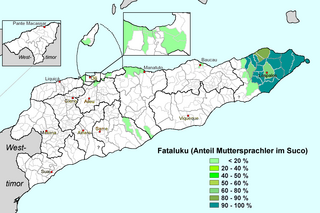
Fataluku is a Papuan language spoken by approximately 37,000 people of Fataluku ethnicity in the eastern areas of East Timor, especially around Lospalos. It is a member of the Timor-Alor-Pantar language family, which includes languages spoken both in East Timor and nearby regions of Indonesia. Fataluku's closest relative is Oirata, spoken on Kisar island, in the Moluccas of Indonesia. Fataluku is given the status of a national language under the constitution. Speakers of Fataluku normally have a command of Tetum and/or Indonesian, those speakers who are educated under Portuguese rule or from younger generation educated under Portuguese-language educational system during independence speak Portuguese.
The Araucanian languages are a small language family of indigenous languages of the Americas spoken in central Chile and neighboring areas of Argentina. The living representatives of this family are Mapudungun and Huilliche, spoken respectively by the Mapuche and Huilliche people. These are usually considered divergent dialects of a single language isolate.

Atauro, also known as Kambing Island, is an island and municipality of East Timor. Atauro is a small oceanic island situated north of Dili, on the extinct Wetar segment of the volcanic Inner Banda Arc, between the Indonesian islands of Alor and Wetar. The nearest island is the Indonesian island of Liran, 13.0 km (8.1 mi) to the northeast. At the 2015 census, it had 9,274 inhabitants.

Manatuto is one of the municipalities of East Timor, located in the central part of the country. It has a population of 45,541 and an area of 1,783.3 km2. The capital of the municipality is also named Manatuto. It is the least populated municipality of East Timor.
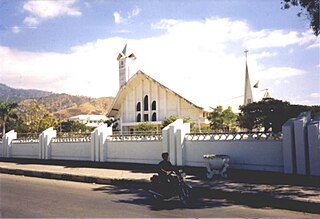
Dili Municipality is one of the 14 municipalities, formerly districts, of Timor-Leste, and includes the national capital Dili. The municipality had a population of 277,279 as of 2015, most of whom live in the capital city.
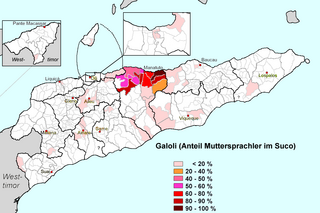
The Galoli, or Galolen, are a people of East Timor with a population of about 50,000, primarily along the northern coast of the district of Manatuto. To the west lies the Mambai people. There is an old colony on the southern coast of Wetar island, the Talo, who speak the Talur dialect.

Kawaimina is a cluster of four languages and dialects of East Timor:
Wetarese is an Austronesian language of Wetar, an island in the south Maluku, Indonesia, and of the nearby island Liran.
Lungalunga, frequently though ambiguously called Minigir, is spoken by a small number of the Tolai people of Papua New Guinea, who live on the Gazelle Peninsula in East New Britain Province. It is often referred to in the linguistics literature as the Tolai "dialect" with an.

Papua New Guinea, a sovereign state in Oceania, is the most linguistically diverse country in the world. According to Ethnologue, there are 840 living languages spoken in the country. In 2006, Papua New Guinea Prime Minister Sir Michael Somare stated that "Papua New Guinea has 832 living languages ."
The Timoric languages are a group of Austronesian languages spoken on the islands of Timor, neighboring Wetar, and Southwest Maluku to the east.

Geoffrey Stephen Hull is an Australian linguist, ethnologist and historian who has made contributions to the study of Romance, Celtic, Slavonic, Semitic, Austronesian and Papuan languages, in particular to the relationship between language and culture.
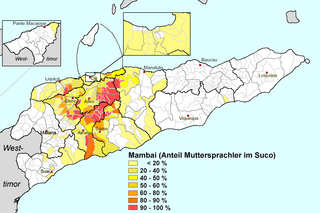
Mambai, also called Mambae or Manbae, is a language spoken by the Mambai people, the second largest ethnic group in the island country of East Timor.

Naueti is an Austronesian language spoken by 15,045 in the subdistricts of Uato-Lari, Uatucarbau and Baguia in southeastern East Timor. 1,062 Naueti are living in Baguia.

Kairui-Midiki is a language of East Timor spoken by 23,000 people in 2015, primarily in Venilale Administrative Post in Baucau, parts of the Viqueque Municipality, and suco Kairui.

Idalaka is a Malayo-Polynesian dialect chain spoken in East Timor. The name is a portmanteau of Idaté and Lakalai.

Manatuto, officially Manatuto Administrative Post, is an administrative post in Manatuto municipality, East Timor. Its seat or administrative centre is the suco of Sau.
